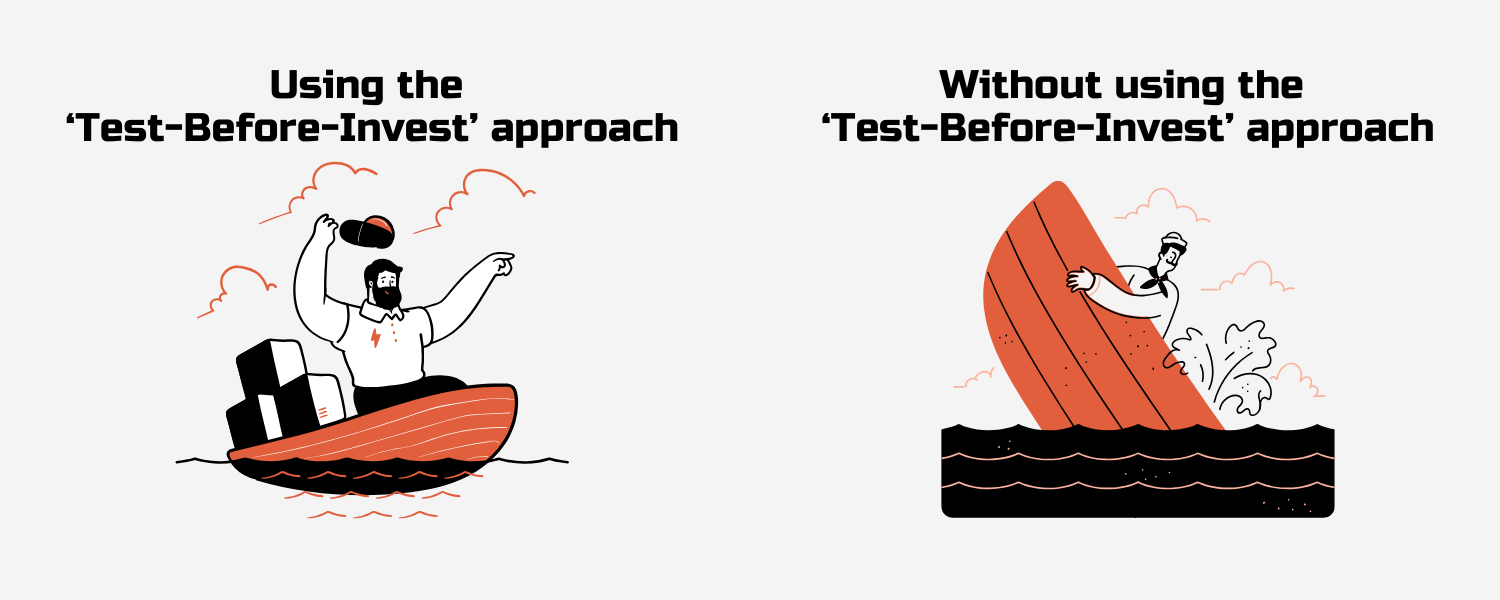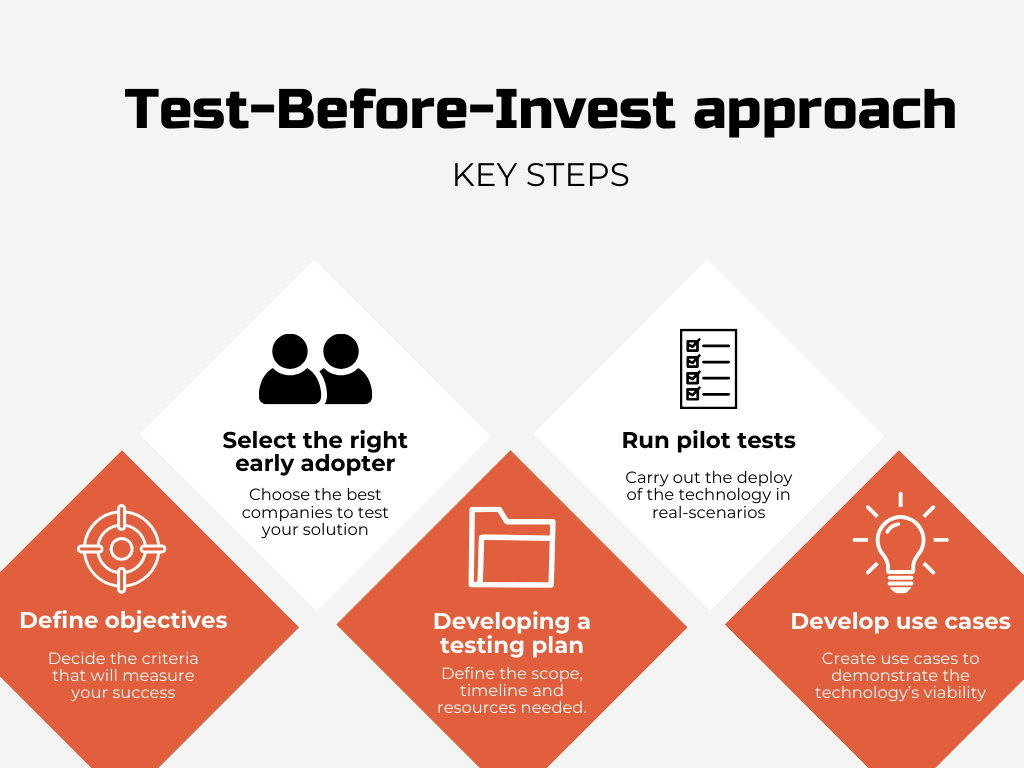
What is the Test Before Invest approach and how might save you millions in your technology market entry strategy
Approximately 95% of new products fail, often due to inadequate market validation and testing. Innovation is crucial for staying competitive in manufacturing, but launching new technology without validation can lead to costly failures. The Test-Before-Invest approach minimises risks by allowing companies to pilot-test solutions before full-scale implementation.
In this article, we’ll explore how Test Before Invest helps manufacturers reduce risk, optimize investments, and ensure market adoption. We’ll also share how Techfinders, an online platform connecting research centres and R&D-driven companies with manufacturing SMEs, supports developers in overcoming market entry barriers.
What is the Test Before Invest approach?
The Test Before Invest approach is a methodology that enables companies to evaluate new technologies in a controlled environment before large-scale deployment.
It involves a complex process that normally goes from proof-of-concept (PoC) testing, which is an early-stage experiment conducted in a controlled setting to assess whether a technology is technically feasible and delivers the expected results.

Once a PoC confirms viability, the next step is to look for a pilot project to test this technology in real scenarios. This first small-scale implementation in a real-world environment helps developers to test the technology’s performance, usability, and potential challenges under actual operating conditions.
By combining PoC testing, pilot projects, and technology industrial trials, this approach helps businesses validate a technology’s reliability and market viability before committing to full-scale adoption, reducing risk and optimizing investment decisions.
From the side of the first adopters of technology, testing emerging technologies at ‘no cost’ allows companies to validate their feasibility before committing to any investment. This way, businesses are matched with the right partners to collaborate and test solutions in real-world conditions. This approach helps optimize technology development, ensuring alignment with market needs while gathering valuable feedback from potential users.
Why ignoring Test Before Invest can lead you to failure
Refusing to pilot testing innovations before full-scale implementation can lead to significant setbacks. Google’s investment in Google Glass, for example, resulted in a product that quickly disappeared from the market due to usability and privacy concerns.
Operational disruptions are another major risk as the technology may not perform as expected under real-world conditions. On the other hand, avoiding using this pilot programme can result in low adoption rates which means when a new product or innovation fails to gain widespread acceptance among its intended users.
This often results from inadequate market research, poor understanding of customer needs, or insufficient testing before launch. A clear example of this failure is the Microsoft case when launching their entertainment platform Zune.
Beyond financial losses and compliance issues, skipping pilot testing can destroy stakeholder confidence. Stakeholders, including investors, partners, and customers, rely on the evidence of successful testing to measure the viability and potential of a new technology. Without a proven track record from pilot testing, these stakeholders may view the technology as too risky or unproven, which can lead to a loss of trust and support.
The 5 most important benefits of implementing the Test Before Invest approach
To optimize the return on investment and minimize innovation risks, test-before-invest provides:
- Early issue detection: Identifies technical flaws before mass production.
- Cost savings: Prevents expensive reworks and last-minute changes.
- Investor confidence: Demonstrates technology viability before full-scale investment.
- Faster market adoption: Ensures that the solution meets industry and customer requirements.
- Regulatory compliance: Helps companies align with safety and quality standards.
How to implement a Test Before Invest strategy
To optimize the return on investment and minimize innovation risks, test-before-invest provides:
- Early issue detection: Identifies technical flaws before mass production.
- Cost savings: Prevents expensive reworks and last-minute changes.
- Investor confidence: Demonstrates technology viability before full-scale investment.
- Faster market adoption: Ensures that the solution meets industry and customer requirements.
- Regulatory compliance: Helps companies align with safety and quality standards.

- Define objectives: Identify key success criteria for the pilot test. Understand what you hope to achieve and the metrics that will determine success. Clear objectives help align your testing process with your business goals.
- Select the right early adopters: Collaborate with companies willing to test and provide feedback on your technology in real-world conditions. Early adopters play a critical role in validating your solution, helping you refine it before a full-scale launch. On Techfinders, we help you connect with the right first users for your technology validation and testing opportunities across Europe, streamlining your access to the right resources for successful pilot projects.
- Develop a testing plan: Outline key performance indicators (KPIs) and success metrics. Define the scope, timeline, and deliverables for your pilot testing phase. This plan should align with your business objectives and ensure that critical questions are addressed during the test.
- Run pilot tests: Deploy the technology in a real-world or simulated environment. Monitor and assess its performance, usability, and scalability in operational settings. Ensure you gather feedback from first users and stakeholders to understand the technology’s potential challenges and opportunities. See an example here about how Irepa Laser (tech developer) worked with Technogenia (early adopter) in this Tests-before-invest approach.
- Analyze results and develop use cases: Assess the performance data, identify any issues, and make improvements. Pilot testing is a dynamic process, and iteration is key to refining the technology. Make necessary adjustments based on feedback and results before scaling up. Additionally, develop use cases based on real-world applications to demonstrate the technology’s viability and value proposition to potential customers.
Test Before Invest is a powerful tool for manufacturers looking to innovate while minimising risks. By validating technology before full deployment, companies can save costs, enhance efficiency, and accelerate market adoption. If you’re considering a new technology investment, integrating Test Before Invest into your strategy can be the key to success.
Ready to explore Test Before Invest for your innovation strategy? Contact us to learn how we can support your pilot testing initiatives

About the author
María Páez Guerrero
Tech Transfer Department Marketing Coordinator and Techfinders Product Owner
María leads the marketing at the Technology Transfer department and drives product strategy and marketing at Techfinders, helping manufacturing developers craft compelling value propositions for their solutions and connect with a strong online community. Her work ensures that SMEs can seamlessly access and adopt innovative technologies.
